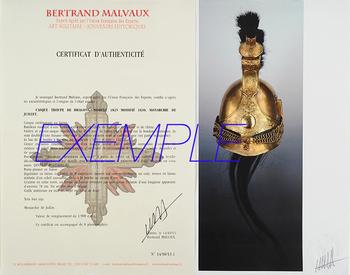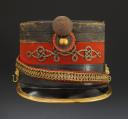
HUSSARD OFFICER'S SHAKO, type 1872 test model in use with the 8th regiment, Third Republic. 27180
Sold out
HUSSARD OFFICER'S SHAKO, type 1872 test model in use with the 8th regiment, Third Republic. 27180
Cylindrical cardboard frame (not leather) covered with a madder cloth sleeve. Cap and bourdalou in black patent leather. Large bourdalou, H 3.5 cm, in one piece and not two. “Cul de dé” woven braid (more often lizard woven) in silver trimmings striped in its center, H 3.5 cm (in 1874 it was reduced to 2.8 cm). Tricolor metal cockade attached to the barrel by means of a half-spherical button in gilded metal and a braid in mixed silver trimmings. At the front of the shako, Hungarian knot in silver braid. On each side of the barrel in the upper part, a madder lacquered brass aerator is fixed and in the lower part a lion's head in gilded brass intended to attach the chin strap. At the back at the top, a third lion's head in gilded brass. Visor in black waxed leather lined with green leather and bordered with a gilded brass bangle. Inner headdress composed of a black patent leather headband with purple silk headdress. Curb chinstrap composed of seventy-nine intertwined rings in gilded brass, mounted on a leather chin strap lined with madder cloth. Half-spherical wooden pompom covered with silver threads, D 3.5 cm.
H of the shako at the front 11 cm, at the back 12 cm.
France.
Third Republic.
Very good condition, oxidation from use of the trimmings, interior cover worn with accidents and some losses.
HISTORY by Louis Delpérier:
At the start of the Third Republic, a new form of cylindrical shako was adopted in 1872, thus breaking with the tradition of frustoconical shakos. The introduction of a first model, tested by the 12th Hunters and 8th Hussars, was brought to the attention of the public by L'Avenir Militaire of May 17, 1872. With an average height of 115 mm from the front, it is covered with madder cloth with black (hunter) or white (hussar) upper braid. Copper hunting horn or white wool Hungarian knot on the headband. Straight plume of 120 mm, red (Hunters) or white (Hussars) with black feathers at the base. The gourmet chinstrap is that of the old talpack, the copper-rimmed visor, that of the old czapska of the spearmen: these details clearly locate the origin of these accessories present on the future 1874 model. The same newspaper learned from the 2 October that the manufacture of this schako, a silhouette considered ridiculous, was stopped, which General de Cissey confirmed to the Chamber on July 16, 1873. On this date, it was therefore the kepi which took the place of the headdress. order on a quasi-general basis.
“During the session of July 16, 1873, General de Cissey revealed the existence of another model, also being tested at the 12th Chasseurs and 8th Hussars, and of which nothing was known: a first model was made which was ridiculed by the small newspapers (Ah! Ah!) and although it was recognized as very convenient, it was abandoned (new exclamations). Sorry, gentlemen, when it comes to state spending, things are serious (Yes! Speak!). Only two regiments are equipped with this hairstyle; they use it. I was offered another one. I authorized this hairstyle to be admitted into service in only two regiments, and this is why there are two hairstyle models at the moment. In the provinces, the regiments only have one, the cap. In the design of the Hungarian knot, the traditional central loop is most often replaced by two loops on the 1872 model.
It was in St-Germain then Fontainebleau that the riders of the 8th Hussars equipped with the 1872 model schako saw their appearance judged by the public. It would probably have been enough for the sleeve to be sky blue in color for the schako to be more successful. The craze for frustoconical hairstyles eventually shifted to cylindrical hairstyles around fifteen years later, as shown by the evolution of the kepi.
On January 24, 1874 the second model of shako, this frustoconical one was adopted and would last until the First World War.
NOTE :
According to Louis Delpérier in the work “THE LIGHT CAVALERIE FROM 1845 TO 1915” volume second page 62 illustration n° 915, edition of Le Canonnier 2007 “The trial schako of the type 1872 is even rarer in its version intended for officers, the most of them not having taken the risk of acquiring it. “Hussar officers ask us to say whether the schako will be kept or abandoned” (L’Avenir Militaire, July 17, 1872). On July 16, 1873, the deputy Margaine called out to General de Cissey, who had nonetheless handed over his portfolio to General du Barail on that date: "the other day at the review, you saw our hussars parade. The men all had schakos, the officers did not have one. If the outfit was really appreciated by the troops, the officers would have taken it a long time ago", to which the former Minister replied: "when my successor has found a hairstyle model suitable, he will give some
Cylindrical cardboard frame (not leather) covered with a madder cloth sleeve. Cap and bourdalou in black patent leather. Large bourdalou, H 3.5 cm, in one piece and not two. “Cul de dé” woven braid (more often lizard woven) in silver trimmings striped in its center, H 3.5 cm (in 1874 it was reduced to 2.8 cm). Tricolor metal cockade attached to the barrel by means of a half-spherical button in gilded metal and a braid in mixed silver trimmings. At the front of the shako, Hungarian knot in silver braid. On each side of the barrel in the upper part, a madder lacquered brass aerator is fixed and in the lower part a lion's head in gilded brass intended to attach the chin strap. At the back at the top, a third lion's head in gilded brass. Visor in black waxed leather lined with green leather and bordered with a gilded brass bangle. Inner headdress composed of a black patent leather headband with purple silk headdress. Curb chinstrap composed of seventy-nine intertwined rings in gilded brass, mounted on a leather chin strap lined with madder cloth. Half-spherical wooden pompom covered with silver threads, D 3.5 cm.
H of the shako at the front 11 cm, at the back 12 cm.
France.
Third Republic.
Very good condition, oxidation from use of the trimmings, interior cover worn with accidents and some losses.
HISTORY by Louis Delpérier:
At the start of the Third Republic, a new form of cylindrical shako was adopted in 1872, thus breaking with the tradition of frustoconical shakos. The introduction of a first model, tested by the 12th Hunters and 8th Hussars, was brought to the attention of the public by L'Avenir Militaire of May 17, 1872. With an average height of 115 mm from the front, it is covered with madder cloth with black (hunter) or white (hussar) upper braid. Copper hunting horn or white wool Hungarian knot on the headband. Straight plume of 120 mm, red (Hunters) or white (Hussars) with black feathers at the base. The gourmet chinstrap is that of the old talpack, the copper-rimmed visor, that of the old czapska of the spearmen: these details clearly locate the origin of these accessories present on the future 1874 model. The same newspaper learned from the 2 October that the manufacture of this schako, a silhouette considered ridiculous, was stopped, which General de Cissey confirmed to the Chamber on July 16, 1873. On this date, it was therefore the kepi which took the place of the headdress. order on a quasi-general basis.
“During the session of July 16, 1873, General de Cissey revealed the existence of another model, also being tested at the 12th Chasseurs and 8th Hussars, and of which nothing was known: a first model was made which was ridiculed by the small newspapers (Ah! Ah!) and although it was recognized as very convenient, it was abandoned (new exclamations). Sorry, gentlemen, when it comes to state spending, things are serious (Yes! Speak!). Only two regiments are equipped with this hairstyle; they use it. I was offered another one. I authorized this hairstyle to be admitted into service in only two regiments, and this is why there are two hairstyle models at the moment. In the provinces, the regiments only have one, the cap. In the design of the Hungarian knot, the traditional central loop is most often replaced by two loops on the 1872 model.
It was in St-Germain then Fontainebleau that the riders of the 8th Hussars equipped with the 1872 model schako saw their appearance judged by the public. It would probably have been enough for the sleeve to be sky blue in color for the schako to be more successful. The craze for frustoconical hairstyles eventually shifted to cylindrical hairstyles around fifteen years later, as shown by the evolution of the kepi.
On January 24, 1874 the second model of shako, this frustoconical one was adopted and would last until the First World War.
NOTE :
According to Louis Delpérier in the work “THE LIGHT CAVALERIE FROM 1845 TO 1915” volume second page 62 illustration n° 915, edition of Le Canonnier 2007 “The trial schako of the type 1872 is even rarer in its version intended for officers, the most of them not having taken the risk of acquiring it. “Hussar officers ask us to say whether the schako will be kept or abandoned” (L’Avenir Militaire, July 17, 1872). On July 16, 1873, the deputy Margaine called out to General de Cissey, who had nonetheless handed over his portfolio to General du Barail on that date: "the other day at the review, you saw our hussars parade. The men all had schakos, the officers did not have one. If the outfit was really appreciated by the troops, the officers would have taken it a long time ago", to which the former Minister replied: "when my successor has found a hairstyle model suitable, he will give some
Reference :
27180

Next update Friday, april 4th at 1:30 PM
FOR ALL PURCHASES, PAYMENT IN MULTIPLE CHECKS POSSIBLE
bertrand.malvaux@wanadoo.fr 06 07 75 74 63
An authenticity certificate of the item including the description published on the site, the period, the sale price, accompanied by one or more color photographs is automatically provided for any item priced over 130 euros. Below this price, each certificate is charged 5 euros.
Only items sold by me are subject to an authenticity certificate, I do not provide any expert reports for items sold by third parties (colleagues or collectors).







